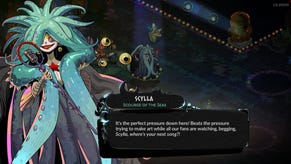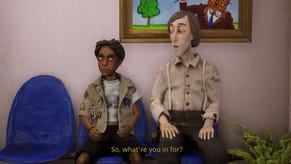Phantom Fury review: a retro shooter obsessed with inconsequential do-hickeys
No arm in trying
Hurtling along on top of a train full of goons in Phantom Fury you will see another rushing train pulling up at matching speed, inviting you to hop from one to the other. A helicopter will soon join the fray. Many things will soon explode, and you will take a short break from the minigunning to calmly physics some boxes into a set of steps with a crane. This FPS is not so much writing a love letter to a bygone era of noughties shooters, as it is standing underneath the window of its respected elders earnestly serenading them with a busted old keytar from the attic. There are bum notes and the singing voice is not exactly boy-band beautiful, but the love is unmistakably there. And, hey, singing is hard.
This is a sorta-sequel to Ion Fury, the throwback shooter of 2019 developed in the Build Engine (the same codey soup from whence Duke Nukem crawled many years previously). But there's no pre-requisite to understand the story of the predecessor here. If you aren't following the adventures of Shelly "Bombshell" Harrison, just know that America is under threat and that you and your new cybernetic arm are on a mission to save the day.
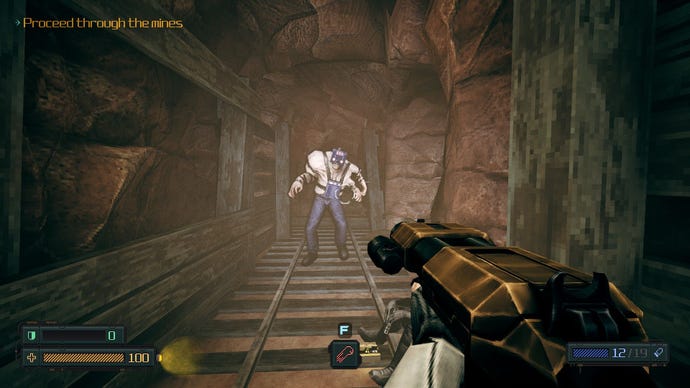
This arm is the beasty melee button that is, admittedly, a little underutilized outside of combat. It can turn an enemy to chunks, with a short cooldown. And alongside other goodies dripfed to Shelly (a bullet-absorbing shield, a powersuit full of health bonuses) it all serves the classic running, gunning and slurping down sodas as you pass them mid-fight. You can also pick up and chuck crates, barrels or - risky - the ticking timebomb of a downed drone.
Full disclosure: I am an easy mark for a nostalgic roll-out of the genre conventions of yore, such as are displayed here. There are monster closests, security cameras that follow your every move, usable vending machines that dispense healing cola, strummable guitars, ceiling fans with adjustable speed controls, arcade machines to play, basketballs with nets that invite you to shoot some hoops, beer taps to pump. The bathrooms are a particular ode to old-school detail. Not content with allowing you to flush the toilets, the developers have made it possible to whip round the toilet roll, run the taps, dispense soap, and tear off paper towel after paper towel.
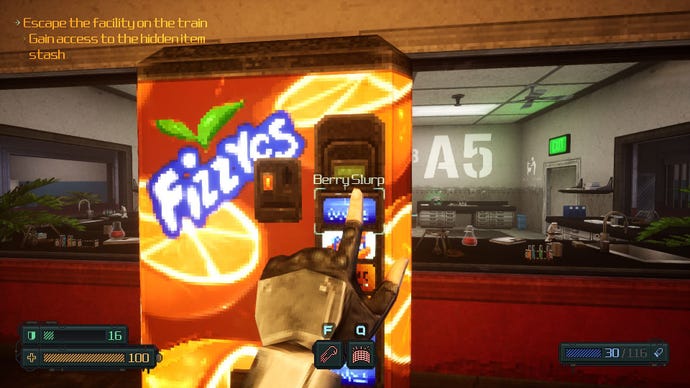
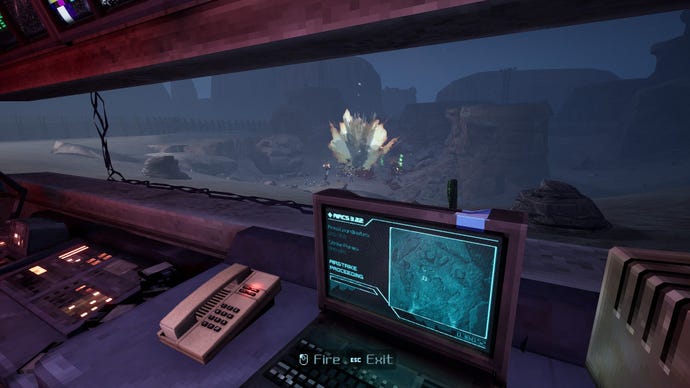
When I mentioned this to the RPS gang, Graham asked if it was likely this devotion to incidental interactivity would last past the opening levels. Counter to expectation, it does. I haven't completed the game, but almost every level has some new silliness to it. A lab with glass test chambers full of robots to incinerate at the press of a button. Firewatch towers with little radios to tune. Before I start piercing the game's ribcage with my critic's poker, I do want to establish that the attention to (arguably unnecessary) interactive detail is something I love and often miss in modern shooters.
But holepoke I must. This is a departure from its predecessor in the sense that the fluidity and slipslidiness of the Build Engine has been replaced with slightly more clunkersome movement. So if you have an immovable preference for The Way Things Were, that altered sense of weight might throw you off.
What took me more getting used to was the enemy movement. Soldiers put pressure on you with grenades and ill-advised rush-downs (guys, the lady has a MEGA ARM). While flying drones pester you with agile hovering. All their behaviour makes sense in terms of shootsemsups but something about their dashing, their sudden path changes, feels jerky. And the hardiness of some later enemies undermines the otherwise crackling firearm feedback.
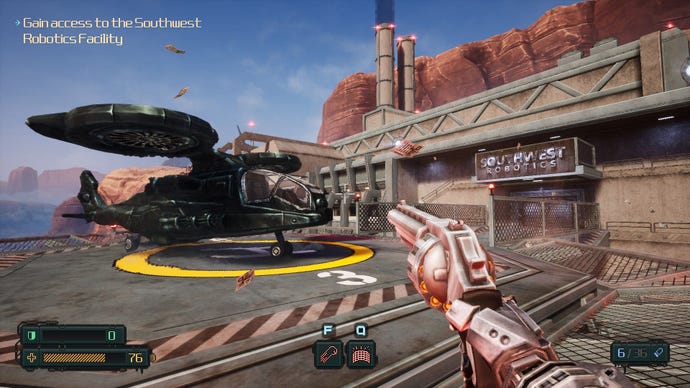
There's also some visual communication snafus. Many doors, vents and passageways that look as if they're accessible don't really serve a purpose. Some obstructions look pummelable but are not. Some reddish barrels that look Explosive™ are not really Explosive™. Some waist-high surfaces appear mountable, but your knees will not tolerate such an imposition, as if this superhuman woman is offended by the very idea of hoisting. In design vernacular this is an "affordances" issue. In normal human talk, it's the game not letting you do stuff you expect to be able to do.
At its worst moments this leads to whole areas becoming hard to read. One moment that stands out is a desert pass surrounded by snipers, where the game seems to be saying "don't step out into the open" when really, the open space is exactly where you have to go. Phantom Fury is going for a kind of "set up and payoff" style of level design. But the payoffs are often unreliable and some of your solutions are simply not accounted for. I got close and hit one of these snipers through the mesh that obscured them, for example. The blood flew out of them, they grunted in pain, but would not die. It was like shooting The Crow.
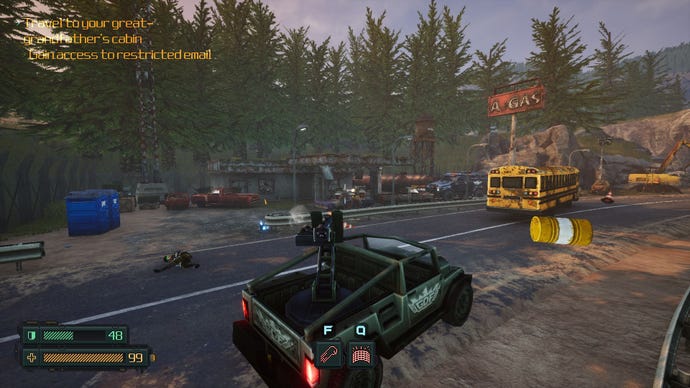

I don't fault the game too hard for these mis-steps. It is the double-edged sword of building an old-school shooter that toys with player expectations. You'll please players when they press a button and it does something incidental and fun. But then they start investigating everything in every room, and the limited nature of the world becomes apparent. As a player, once you start seeing incidentally interactive objects, you start checking if EVERYTHING is interactive. Ultimately, we can be victims of disappointment because video games, I am often shocked to recall, are not real.
Conversely, as a designer, you have to set the rules of the world firmly while encouraging curiousity and play, building an in-world visual language around what is important, and what is just fluff. Phantom Fury is ambitious in this regard, but it's a demanding magic trick to pull off. The effect is that you get a lot of laughs, some moments of "haha, neat!" yet other moments in which it's difficult to know what the game is going to permit. In a setpiece shooter where you are encouraged to be creative, not being able to climb a waist-high ledge, or shoot a man through thin cloth, can be jarring.
That flow-breaking also might occur for some during puzzles where you actually have to stop, breathe, and use your noggin. For example, finding an antler to plug into a taxidermy trophy to reveal a secret lab entrance, when no clues about such a contraption have been previously seeded. There's also a need to employ the old Doom practice of mentally noting locations of any door locked by a keycard, because although the levels do their best to avoid backtracking, you still often need to make the final leap of logic when it comes to navigating many levels.
Complaints aside, when the triggerhappy setpieces work they are exciting in a retro way. At one point you call in an airstrike via a tactical map on a computer screen while looking out the window at your explosive results in real time. BLOOD! At the end of another level you escape in a helicopter through the grand canyon. In another, you roll through ravines in a jeep, machine-gunning pursuers and hopping out every so often to deal with crane-based physics puzzles; a long sequence reminiscent of the vehicle sections of Half-Life 2.
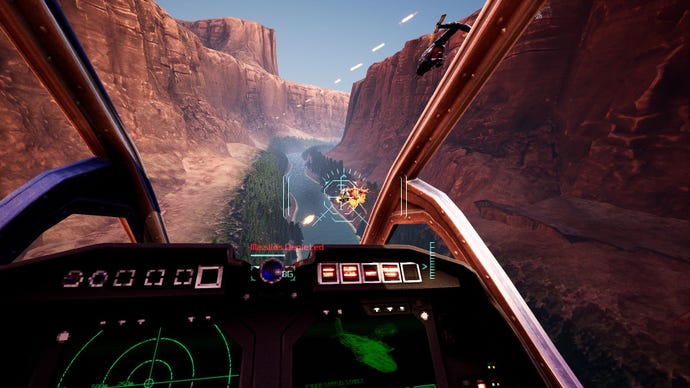
The train level had me particularly happy and impressed. Keeping a level exciting within such a limited, confined space seems difficult to pull off (hello, Hitman 3) but this showstopper had me thinking back to the crowded carriages of Goldeneye 64 and the railroad ruckusing of Timesplitters Future Perfect, all with great fondness (alas, neither is permitted on our PC-centric best FPS games list). While I'm at it, I'm also big fan of the zombies here - they are numerous and angry and not shy of hurling chairs at you like an overworked teacher who has finally had it with your bullshit.
As I've said, I have not seen the whole thing through (I've got real trains to catch) but I'm happy with all the time I spent bumsliding across pixellated metal grates and bowling plum-coloured ba-bombs into mutant legs. Phantom Fury sometimes falters in its basic elements (and it can be a little buggy too - fair warning) but its devotion to detail is so laudable I don't care. Chekhov said that if you have a prop on stage, then that prop must serve a purpose to the story. Hemmingway said, nah, that's bollocks, inconsequential details are important. Phantom's Fury feels like the latter; a devotee of inconsequential gizmos. Its clocks are fully animated gif timepieces. Its cream-coloured PCs make clicking hard drive noises when you switch them on. And, very importantly, its toilets flush.
This review was based on a copy of the game provided by the publisher.



